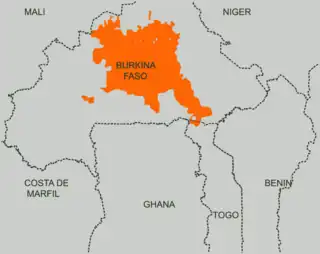Mooré
Mooré is a Gur language of the Oti–Volta branch and one of four official regional languages of Burkina Faso. It is the language of the Mossi people, spoken by approximately 8 million people in Burkina Faso, Ghana, Cote d’Ivoire, Benin, Niger, Mali, Togo and Senegal as a native language, but with many more L2 speakers. Mooré is spoken as a first or second language by over 50% of the Burkinabè population and is the main language in the capital city of Ouagadougou. It is one of the official regional languages in Burkina Faso and is closely related to Dagbani.
| Mooré | |
|---|---|
| Mòoré | |
| Native to | Burkina Faso, Benin, Ivory Coast, Ghana, Mali, Togo, Niger, Senegal |
| Ethnicity | Mossi |
Native speakers | 7.83 million (2009–2013)[1] |
| Latin (Mooré alphabet), N'Ko | |
| Official status | |
Recognised minority language in | |
| Language codes | |
| ISO 639-2 | mos |
| ISO 639-3 | mos |
| Glottolog | moss1236 |
 Majority areas of Mooré speakers (see also on a map of Burkina Faso) | |
| Person | Moaaga |
|---|---|
| People | Mosse |
| Language | Mòoré |
| Country | Moogho |
Phonology
The Mooré language consists of the following sounds:[2]
Consonants
| Labial | Alveolar | Postalveolar / palatal |
Velar | Glottal | ||
|---|---|---|---|---|---|---|
| Nasal | m | n | ɲ | |||
| Stop | voiceless | p | t | k | ʔ | |
| voiced | b | d | ɡ | |||
| Fricative | voiceless | f | s | h | ||
| voiced | v | z | ||||
| Liquid | r, l | |||||
| Approximant | j | w | ||||
Remark:
Vowels
| Front | Central | Back | ||
|---|---|---|---|---|
| Close | close | i | u | |
| near-close | ɪ | ʊ | ||
| Close-mid | e | o | ||
| Open | a | |||
Notes:
Orthography
In Burkina Faso, the Mooré alphabet uses the letters specified in the national Burkinabé alphabet. It can also be written with the newly devised goulsse alphabet.
| Burkinabé Mooré alphabet | |||||||||||||||||||||||||
|---|---|---|---|---|---|---|---|---|---|---|---|---|---|---|---|---|---|---|---|---|---|---|---|---|---|
| A | ʼ | B | D | E | Ɛ | F | G | H | I | Ɩ | K | L | M | N | O | P | R | S | T | U | Ʋ | V | W | Y | Z |
| a | ʼ | b | d | e | ɛ | f | g | h | i | ɩ | k | l | m | n | o | p | r | s | t | u | ʋ | v | w | y | z |
| Phonetic values | |||||||||||||||||||||||||
| a | ʔ | b | d | e | ɛ | f | ɡ | h | i | ɪ | k | l | m | n | o | p | r | s | t | u | ʊ | v | w | j | z |
See also
References
- "Mòoré". Ethnologue. Retrieved 2018-12-06.
- Cf. Kabore (1985) : (p.44) for the consonants, (p.85-86) for the vowels.
External links
Learning materials
- Protestant Mission, Assemblies of God. More (Language of the Mossi Tribe) Phrase Book. Ouagadougou, Upper Volta: World Digital Library.